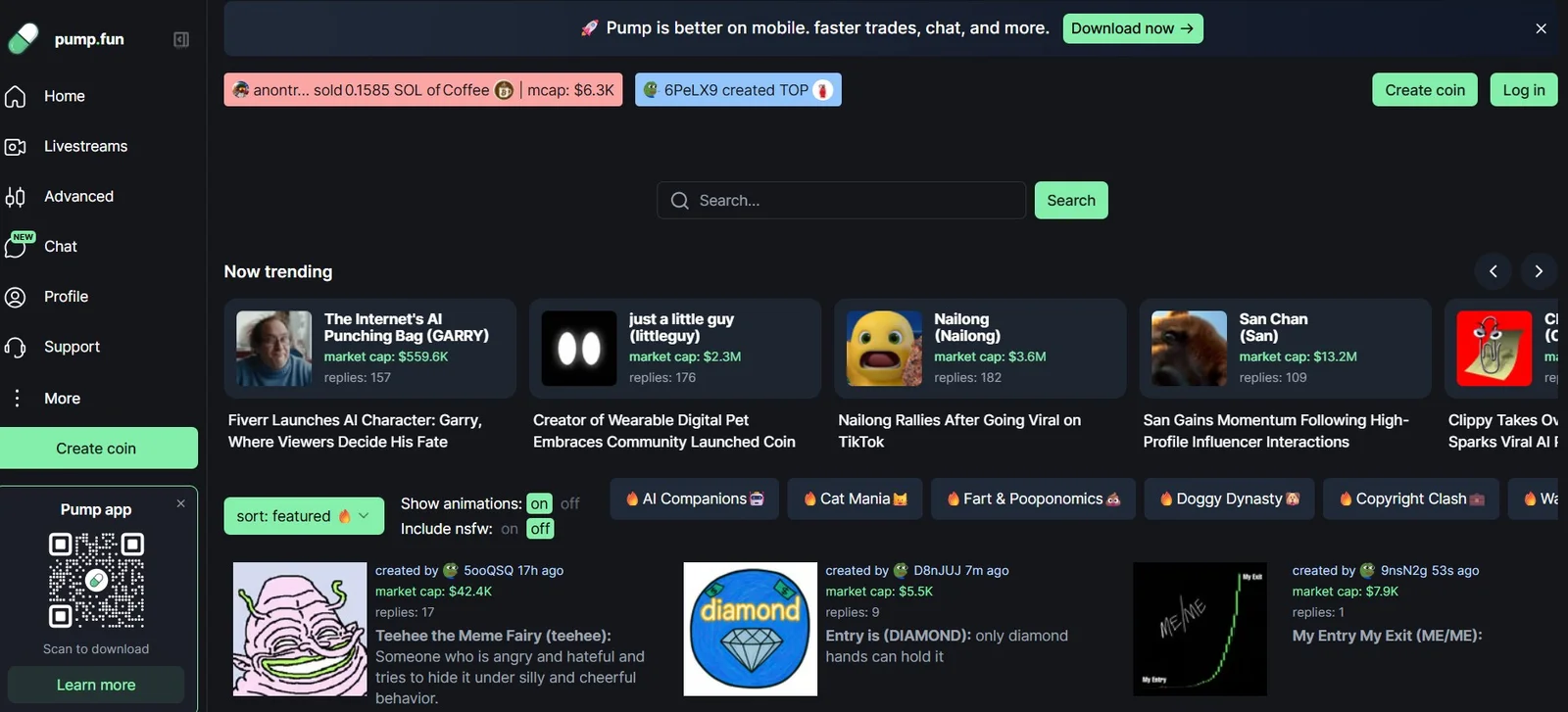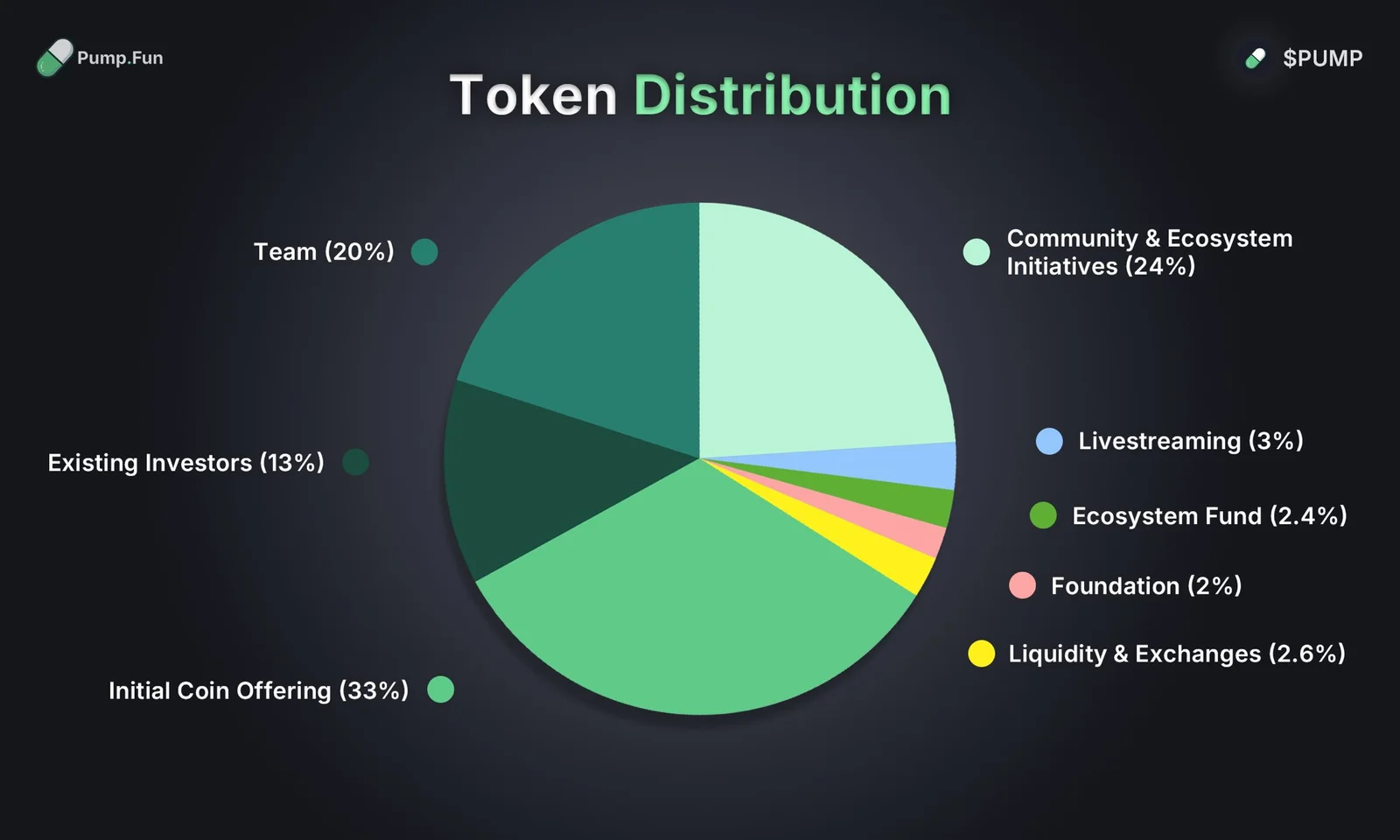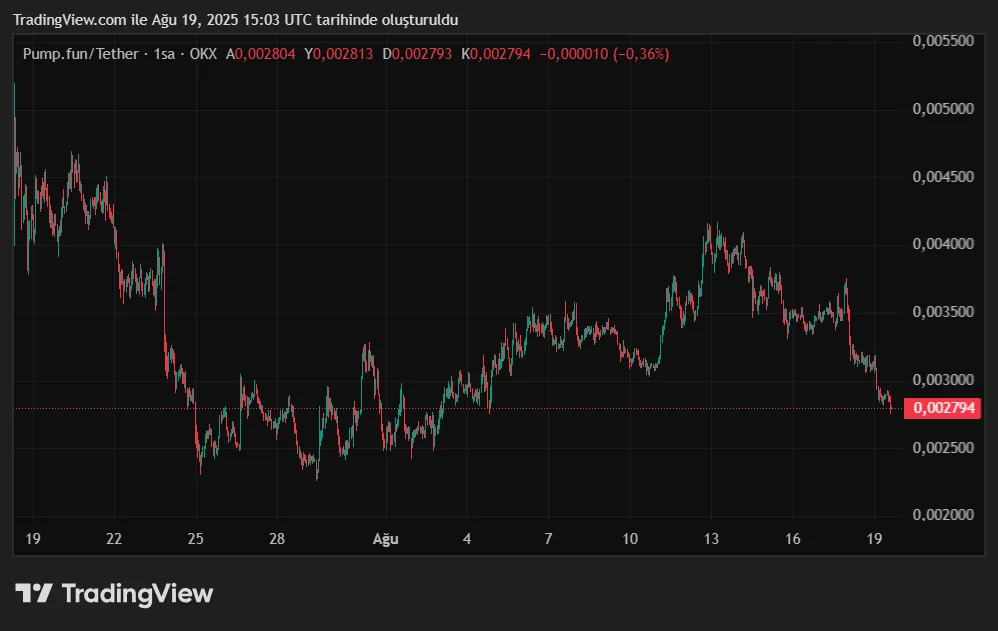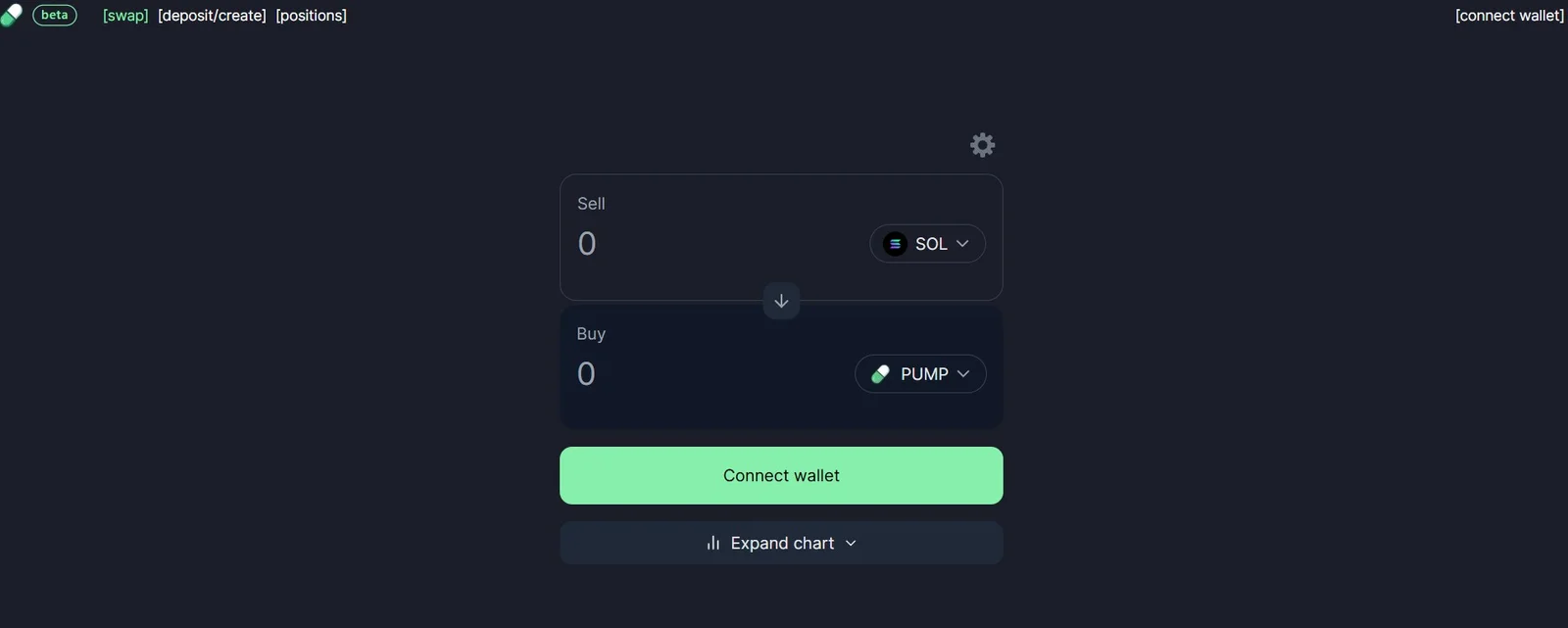Meme coin projects have undoubtedly been one of the most entertaining and chaotic trends in the crypto world in recent years. This trend, which began with Dogecoin and continued with legends like Shiba Inu and Pepe, is now the new darling of Pump.fun, which launched with the motto "everyone should be able to issue their own coin." For those wondering what pump.fun is, we can briefly explain it as follows: This platform runs on the Solana network, a meme coin factory where you can create and launch your own token in minutes. In other words, if you have an idea or a funny joke, you can turn it into a coin with just a few clicks.
Pump.fun's origin story is as spontaneous and entertaining as the coins themselves. Launched in early 2024, this platform's goal was to make the crypto world a little more "fun." Being able to issue a coin without getting bogged down in technical details, writing a massive whitepaper, or dealing with major investors... It's precisely this freedom that quickly made Pump.fun a trending topic on social media. This ecosystem, which simplifies the creation of community coins, also offers users governance and ease of transaction through its native token, PUMP.
In this guide, you'll find everything you need to know about Pump.fun, from how it came to be to key milestones like its launch date and history, to the benefits of Pump.fun and its price history.
Pump.fun's Definition and Origin
Pump.fun stands out as a decentralized token launch platform. This means anyone can easily create their own cryptocurrency, especially meme coin-style tokens, without needing to know any technical coding. Simply connect a Solana wallet, enter the token name, symbol, and optional image, and a new coin is born and available for trading within seconds. This fast and simple process facilitates the creation of projects with a high potential for virality on social media. In short, Pump.fun is seen as a pioneer in the crypto world, where "everyone can launch their own coin."
The platform's origins date back to January 2024. Initially launched by an anonymous team of developers, the founders concealed their identities and embraced a completely community-driven, decentralized vision. Initially, they were referred to only by pseudonyms; for example, the initial developer who announced the project used the name "Alon." It later emerged that Pump.fun is backed by young UK-based entrepreneurs Noah Tweedale, Alon Cohen, and Dylan Kerler. These three individuals, frustrated by the meme coin craze and the accompanying fraud risks, set out to create a more fair and entertaining environment. The project is driven by the vision of "being the most fun place on the internet."
Pump.fun's founding purpose is to bring fun and community interaction to the crypto ecosystem. New tokens are released in a completely fair manner, without any pre-sale or special team allocations. This allows everyone to start on the same footing. The meme coin culture already holds significant importance in terms of small investments, high-yield dreams, and community support. This is where Pump.fun comes in, creating a platform for community coins with high viral potential to grow rapidly. As a result, Pump.fun has become an innovative ecosystem that expands upon the path blazed by popular examples like Dogecoin and Shiba Inu, allowing users to easily create their own "pump coins."

Pump.fun's History: Major Milestones
After Pump.fun's arrival, events unfolded rapidly. Sometimes surprising, sometimes amusing, but always creating a buzz in the crypto world, milestones emerged. Let's take a look at Pump.fun's short but eventful history:
- January 2024 - Launch: The platform officially launched on January 19, 2024. Hundreds of thousands of tokens were created on the Solana network in the first weeks, and user interest exploded. By mid-2024, the number had reached millions. By July 2024, it was reported that more than 1 million tokens had been created on Pump.fun. This rapid pace made the project known as one of the fastest-growing applications in crypto history.
- Late 2024 - First community movements: Despite the project's anonymous nature, the community quickly organized. On social media platforms (especially Twitter/X and Discord), Pump.fun users began sharing their experiences and discussing newly released meme coin projects. Several successful tokens created on the platform quickly gained value, leading to viral stories like "coins released from Pump.fun." During this period, the platform became known as "Solana's meme coin factory" and attracted attention in the crypto media. The community was also discussing the idea of the platform launching an official token towards the end of 2024. Indeed, the development team had already begun preparations to crown the platform's success with an official token.
- First official token (PUMP) announcement: In the first half of 2025, the Pump.fun ecosystem token, PUMP, was officially announced. The maximum supply was set at exactly 1 trillion. This brought the price per token down to less than a penny, making it possible to acquire a significant amount of PUMP even with small amounts. A wave of excitement swept through the community, and airdrop expectations began to be discussed. Meanwhile, the platform made headlines with the trading volume it generated on Solana. By mid-2025, it was announced that it had generated approximately $800 million in transaction fee revenue.
- July 2025 - Record ICO Sale: The public sale (ICO), held on July 12, 2025, literally made history. Originally scheduled to last three days, the sale ended in just 12 minutes. During this time, $500 million was raised. The ICO price was set at $0.004, and a total of 125 billion PUMP tokens were sold. Including the private sales, the project raised $1.2 billion and reached a market capitalization of approximately $4 billion. Thus, Pump.fun became one of the largest and fastest ICOs in crypto history. The token distribution was as follows:

- Exchange listings and initial price movements: Immediately following the ICO, in mid-July 2025, the PUMP token began listing on various cryptocurrency exchanges. Initially, global exchanges such as Bybit, Kraken, KuCoin, Bitget, Gate.io, and MEXC simultaneously listed PUMP. Crypto.com even announced that it would open PUMP deposits after the ICO and activate the trading pair once certain liquidity conditions were met. Driven by these listings, the PUMP token price took off quickly. With an ICO price of $0.004, the token opened at $0.0056 in its initial trading on exchanges, representing a roughly 40% premium, and continued to rise. Its all-time high (ATH) of $0.006812 was reached on July 17, 2025. This level represented a roughly 70% increase compared to the ICO price. The community was quite excited by this early price performance, and “pump coin rich” jokes started circulating on social media. Pump coin price moved as such:

- Late July 2025: Volatility and airdrop discussions: Unfortunately, the honeymoon period for the PUMP token was short-lived. Large investors participating in the ICO, the "whales" who acquired significant amounts of tokens in the private sale, quickly began making large transfers to exchanges. In fact, just two large private investor wallets sent over $160 million worth of PUMP to exchanges within a week of launch. This selling pressure drove the price down, and on July 21, 2025, PUMP reached an all-time low of $0.003642. This value was 46% below its peak and below the ICO price. In other words, even investors who had bought tokens from the ICO but hadn't yet sold them were, on paper, incurring losses. The most controversial topic within the community at this time was the airdrop, which the team had previously hinted at.
- August 2025 - Community reactions and competition: Before and after the ICO, the Pump.fun team hinted at a potential future airdrop for the community. Most users expected to share in the platform's high transaction volume and revenue. However, in a Twitter livestream at the end of July, co-founder Alon Cohen announced that the airdrop would not take place for now. This announcement was the final straw. Because the livestream was hosted by popular crypto influencer Threadguy, it reached a very large audience and became known as "Pump.fun's funeral" within the community. The lack of a clear roadmap and the lack of any buyback plan or incentives further alienated investors. As a result, large wallets began selling rapidly. For example, one of the largest private investors sold 25 billion PUMP tokens between July 16th and 27th, generating a profit of $8.2 million. The impact of these sales pushed the PUMP price below $0.003, and its market capitalization quickly eroded by over $1 billion.
- Competing projects and current situation: The loss of confidence experienced by Pump.fun paved the way for competitors to emerge in the ecosystem. A similar Solana meme coin platform, Bonk.fun, saw rapid growth in mid-2025. Bonk.fun quickly gained a market lead with its community-focused approach (token buybacks, rewards, revenue sharing, etc.). Currently, Bonk.fun holds approximately 65% of the meme coin market on Solana, while Pump.fun holds 25%. As pressure mounts on the Pump.fun team, it's rumored to be preparing for various moves. The most frequently discussed topic is their plan to launch their own blockchain, called "Pumpchain," by August 2025. Rumors suggest the team is planning to migrate all smart contracts and token infrastructure on the platform to a new Layer-1 chain capable of 10,000 transactions per second. If this happens, a new snapshot could be taken and a new airdrop could be made to the community. Meanwhile, Pump.fun has also launched a DEX called Pump.swap, which is currently in beta.

Why Is Pump.fun Attracting Attention?
Pump.fun has attracted significant attention in the crypto community since its launch. So, what are the factors behind this project's popularity?
Meme Coin Hype and Viral Marketing
The period between 2023 and 2025 witnessed a meme coin craze in the cryptocurrency world. This trend, which began with Dogecoin and continued with projects like Shiba Inu and Pepe, saw coins based on jokes or internet memes reach incredible market capitalization. Pump.fun became a platform that both fueled and fed this hype. So much so that in July 2025, the total meme coin market capitalization peaked at $87 billion, experiencing a 58% increase in one month. Pump.fun found its place in this viral marketing landscape with the idea that "everyone can create their own Dogecoin." Stories about absurdly named tokens created on the platform and their sudden surge were frequently shared on social media. For example, news of a token created by a user on pump.fun gaining 100x in value in a single day could go viral on Twitter (albeit entirely speculative). Such content reinforced the perception that the platform provided opportunities for "get rich overnight" dreams and attracted more users.
Community Strength and Social Media Impact
Central to Pump.fun's success is a strong community and social media influence. The project emphasized its independence from any central authority, giving its users a voice. PUMP token holders can vote on the platform's future and participate in project governance. This gives investors a sense of being "part of the project." Especially in projects like these, known as community coins in the crypto world, having an active and engaged follower base is crucial. Since launch, the Pump.fun team has grown its community through entertaining posts and meme-friendly language on channels like Twitter (X) and Telegram. Announcements made by the official account are quickly shared thousands of times; For example, news of Crypto.com's listing after the ICO reached hundreds of thousands of people. Meanwhile, content creators and influencers from within the community also contributed to the project's marketing. Some volunteers made YouTube videos explaining "What is Pump.fun and how to use it?", while others shared PUMP analyses on Twitter. This organic marketing proved far more effective for the project than paid advertising. Ultimately, it was precisely this community-social media synergy that propelled Pump.fun to the top of the list of viral cryptocurrency projects.
Low entry cost and high volatility potential
Another reason for Pump.fun's appeal was its characteristics that appeal to investment psychology. Firstly, the very low price of the PUMP token (a mere fraction of a centimeter) can make new investors feel like they're buying cheap. For example, someone who invested $100 in the ICO acquired 25,000 PUMP tokens. Acquiring such a large amount of tokens can be psychologically appealing to investors. Secondly, both newly issued tokens on the platform and the PUMP token itself exhibit very high volatility. Prices can rise exponentially or drop sharply in a short period of time. This volatility attracts risk-takers seeking high returns in the short term. The "buy today, multiply tomorrow" motto, frequently uttered within the Pump.fun community, has attracted many new investors. Of course, the flip side of this is the risk of losing money just as quickly. However, many in the cryptocurrency space willingly enter the equation of high risk = high potential return. Pump.fun has attracted significant interest because it offers a gaming platform that satisfies this gambling urge. In short, its volatile structure, which allows anyone to participate with a low entry cost and promises the opportunity for instant wealth, has fueled interest in the project.
Pump.fun's Developers and Community
The team and community dynamics behind the Pump.fun project were key factors in shaping its trajectory. When Pump.fun first emerged, its developers chose not to highlight themselves. At its launch in early 2024, the team remained anonymous, using only pseudonyms. This isn't surprising in the crypto world, as we've been accustomed to anonymous founders since Bitcoin's creator, Satoshi Nakamoto. In Pump.fun's case, anonymity served as a marketing strategy for the project: the message being, "Since there's no central hub, the founders don't matter; what matters is the community." However, some names emerged during and after the ICO process. Co-founder Alon Cohen, in particular, became the face of community outreach after the PUMP token launch. According to documents released to the press, Alon Cohen and the other founders are known as young entrepreneurs from the UK. In other words, the initial anonymous structure has gradually given way to a more transparent founding team profile. However, in keeping with the spirit of the project, the team remains in the background, striving to navigate the community's voice rather than prioritize it.
Perhaps Pump.fun's greatest strength was its large and passionate community. From the project's early days, many users acted not only as investors but also as volunteer ambassadors. For example, guides, tips, and announcements of new tokens were entirely produced by the community. Even moderators of official Telegram groups were largely volunteers. Thanks to the PUMP token's governance feature, important decisions were made through surveys to gather community input. Indeed, this allowed for the rapid implementation of some platform improvements. The community also contributed to the project's financial success; for example, rewards and referral programs for those who traded the most on the platform were shaped by suggestions from active members.
However, it's important to note that community support is a double-edged sword. Just as thousands enthusiastically championed the project during its rise, criticism can be just as fierce during its decline. The community's reactions following the airdrop's postponement and price crash were a prime example of this. Suddenly, posts harshly criticizing the project team began circulating on Twitter under the hashtag #pumpfun. In other words, community power, if not managed well, can turn against the project. Pump.fun's place in crypto culture can be evaluated precisely through this example: When trust and transparency are lacking in the world of community coins, the masses can quickly turn their backs.
Despite all its ups and downs, Pump.fun has become a phenomenon that has left its mark on cryptocurrency history. Many analysts describe Pump.fun as a cornerstone of the 2024-2025 meme coin craze. Mainstream financial sources like Bloomberg even noted that Pump.fun was one of the biggest drivers of the explosive increase in activity on the Solana blockchain. The project became a phenomenon with its multi-billion-dollar ICO and its millions of users. Of course, it wasn't without its critics: some see Pump.fun as dysfunctional, serving only speculation and "pump-dump" cycles. As a matter of fact, the majority of tokens created on the platform either lose value in a short time or die without receiving sufficient attention.
Frequently Asked Questions (FAQ)
Below are some frequently asked questions and answers about Pump.fun:
- What is Pump.fun, and when did it launch?: Pump.fun is a meme coin creation platform and ecosystem token running on the Solana network. It allows users to easily create their own tokens. The platform launched in January 2024, and its native token, PUMP, was launched in July 2025 (opened to the public through an ICO).
- Who developed Pump.fun?: The project was initially developed by an anonymous team. The founders initially remained anonymous, but names like Alon Cohen and his partners later emerged. It is known that the team also included entrepreneurs like Noah Tweedale and Dylan Kerler. So, while the developers initially remained anonymous, they have become somewhat well-known as the project has grown.
- How does Pump.fun work?: Pump.fun runs entirely on-chain smart contracts. Because it's built on the Solana blockchain, users can use the platform with any Solana-compatible wallet. Anyone can create a new token with just a few clicks and instantly make it available for trading on the platform. The price of newly created tokens is determined by an automated model called the bonding curve - each purchase gradually increases the price, while sales decrease it. This creates transparent pricing, even if initial liquidity is low. The PUMP token is used for fees within the platform, governance votes, and ecosystem-related decisions.
- Is Pump.fun suitable for investment?: This depends entirely on the investor's risk preferences. Pump.fun and similar community coin projects have very high volatility; both large gains and losses can occur in a short period. While the project grew rapidly and attracted considerable attention, it was later shaken by trust issues and price drops. Therefore, it should be considered a highly risky investment. If you believe in the project and see long-term potential, it is best to only invest with amounts you can afford to lose. In any case, it is recommended that you conduct your own research before investing in projects like Pump.fun and carefully evaluate the project's community status and development roadmap.
- How is Pump.fun's price determined?: The price of the PUMP token is determined by the supply-demand balance in the markets. Since PUMP is now traded in the free market after the ICO, transactions between buyers and sellers on exchanges drive the price up and down. While the price initially rose above the ICO price, it subsequently declined due to sales. Factors such as the platform's success, usage rate, and news-based expectations also influence the price. In short, PUMP, like other cryptocurrencies, is priced under constantly changing market conditions. User-created tokens on the Pump.fun platform are initially priced within the platform using a bonding curve model. Once they reach sufficient liquidity, they are transferred to decentralized exchanges and subject to market conditions.
- Is Pump.fun just a meme coin, or does it have a utility?: What is the purpose of the Pump.fun coin? The Pump.fun project has two aspects. While the PUMP token may have the aura of a meme coin when viewed alone, it actually has various uses as the platform's official token. This token provides voting rights in the platform's governance processes, and a portion of transaction fees can be paid with PUMP. It's also stated that it could be used for purposes such as sharing platform revenue and participating in special events in the future. Furthermore, the Pump.fun platform is an ecosystem where countless meme coins can be created in addition to PUMP—it's not just a single coin, but an infrastructure and community project. In short, PUMP is more than just a humor-themed token; it's a tool at the heart of the Pump.fun ecosystem, contributing to its benefits.
Follow the JR Kripto Guide series for the latest developments and community news about Pump.fun.